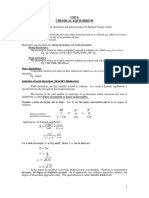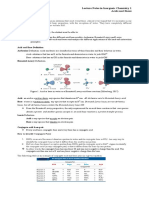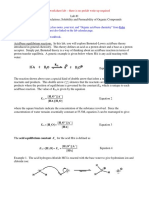Acidity Basicity Kpa
Acidity Basicity Kpa
Uploaded by
lifty23Copyright:
Available Formats
Acidity Basicity Kpa
Acidity Basicity Kpa
Uploaded by
lifty23Original Description:
Original Title
Copyright
Available Formats
Share this document
Did you find this document useful?
Is this content inappropriate?
Copyright:
Available Formats
Acidity Basicity Kpa
Acidity Basicity Kpa
Uploaded by
lifty23Copyright:
Available Formats
Acidity, Basicity and pKa
Page 1 of 8
Acidity, Basicity and pKa
Introduction
Many reactions are catalysed by acids or bases. For example, a protonated carbonyl group is a better electrophile than a normal carbonyl group. pKa tells us how acidic (or not) a given hydrogen atom in a molecule is. pH tells us how acidic a solution is. The basic Bronnsted definition of acids and bases are: o An acid is a species having a tendency to lose a proton. o A base is a species having a tendency to accept a proton. Free hydrogen ions are extremely unstable (so much so that they can even protonate things like methane!) Therefore, for any acid and any base, the equilibrium established is: AH + B A + BH+ Where AH is an acid and A is its conjugate base and B is a base and BH+ is its conjugate acid. In other words, every acid has a conjugate base associated with it, and vice versa. In many such reactions, when acids or bases are dissolved into water, water acts as the acid or base. This ability of water to acts as both an acid and a base makes it an amphoteric compound. To a certain extent, all compounds are amphoteric, because they can always be (de)protonated by a stronger acid/base. When water behaves as a base, it accepts H+ and forms a hydronium ion; H3O+. When it behaves as an acid, it loses a proton, and forms a hydroxide ion; OH. HCl is a very strong acid. It is completely dissociated in solution. Acetic acid, on the other hand, is fairly weak, and it is not fully dissociated.
pH and pKa
The pH of a solution is a measure of the acidity of the solution. It is defined as:
pH log10 [H 3O ]
Daniel Guetta, 2006
Acidity, Basicity and pKa
Page 2 of 8
Where [H3O+] is the concentration of hydronium ions in the solution. Consequently, the pH of a solution depends on two things: o The concentration of the solution if we have two solutions of the same acid, the more concentrated solution will have more free H3O+ ions and therefore a lower pH. o The acid in question if we have two equally concentrated solutions of acids, the solution of a strong acid will have a lower pH than that of a weak acid, because it is more fully dissociated and therefore produces more H3O+ ions. HCl, for example, is completely dissociated. Therefore, we see that pH does not measure the strength of an acid, but the acidity of a given solution. The pH of water is 7. This means that a solution of pure water has a 107 mol dm3 of hydronium ions. This can only happen through the autoprotolysis of water: 2 H2O H3O+ + OH This means that in water, [H3O+] = [OH]. To be clearer about what a strong and weak acid is, we look at the reaction: AH (aq) + H2O (l) Keq:
Keq [H 3O ][A ] [AH][H2O]
A (aq) + H3O+ (aq)
The position of the equilibrium is measured by the equilibrium constant,
Now, in dilute solutions of acid, [H2O] stays roughly constant at about 56 mol dm3. We therefore define a new equilibrium constant the acidity constant Ka:
Ka [H 3O ][A ] [AH]
This is also expressed in logarithmic form are follows:
pK a log10 K a
Because of the minus sign, the lower the pKa, the higher the Ka and the stronger the acid.
Daniel Guetta, 2006
Acidity, Basicity and pKa
Page 3 of 8
It turns that that the pKa of an acid is the pH at which it is exactly halfdissociated. This can be shown by re-arranging the expression for Ka:
[H 3O+ ] = Ka [AH] [A- ]
[AH] pH = pKa - log - [A ]
Clearly, when [AH] = [A], pH = pKa. This information is rather useful: o At a pH above the pKa, the acid exists as A in water, and will therefore be fairly soluble. o At a pH below the pKa, the acid exists mostly as HA in water, and will probably be less soluble. [All vice-versa for a base, of course]. For example, phenol has a pKa of 10: o At a pH of, say, 5, it exists in its acidic form and is a poor nucleophile, because the HOMO is an oxygen lone pair. o At a pH of, say, 14, however, it exists in its conjugate base form, and is a very good nucleophile, because the HOMO is not an oxygen lone pair in an anion. These properties can be used to separate compounds for example, a mixture of benzoic acid and toluene can first be washed with NaOH (the benzoic acid goes into the aqueous layer), and the resulting aqueous layer treated with HCl, which causes the benzoic acid to precipitate.
What makes a strong acid?
HCl is a much stronger acid than acetic acid: HCl + H2O MeCOOH + H2O H3O+ + Cl H3O+ + MeCOO Ka = 107 Ka = 1.74 105 In other words, the
This is to do with the strength (stability) of the conjugate base; Cl is not strong enough to deprotonate H3O+, but acetate is. chloride ion is inherently more stable than the acetate ion. An acids pKa depends on the stability of its conjugate base.
Daniel Guetta, 2006
Acidity, Basicity and pKa
Page 4 of 8
o The stronger the acid HA, the weaker its conjugate base A. o The stronger the base A, the weaker the conjugate acid HA. For example: o HI, with a pKa of 10, is a strong enough acid to protonate most functional groups. Its conjugate base, I, is not really basic at all. o Methyl lithium (MeLi) is a very powerful base, which behaves as CH3. The conjugate acid is methane, which isnt really acidic with pKa = 48! There are several factors that determine the stability of the conjugate base. These include: o Which element the negative charge is on. The more electronegative the element is, the more stable the conjugate base. o How delocalised the negative charge is on the conjugate base. The more delocalised, the more stable the conjugate base. Other factors, apart from the stability of the conjugate base, that affect pKa are: o The strength of the HA bond. o The solvent (how good it is at stabilising the ions formed).
The location of the negative charge
The more electronegative the element on which the negative charge is located, the more stable the conjugate base, and the stronger the acid. For example: pKa of second row Hydrides CH4 48
NH3 33
H2O 16
3
HF 3 because fluorine is much more
Clearly, F is more stable than CH electronegative than carbon.
The strength of the HA bond
Clearly, the stronger the HA bond, the harder it is for the acid to donate a proton, and the weaker the acid becomes. For example: Daniel Guetta, 2006
Acidity, Basicity and pKa pKa of group VII Hydrides HF 3 HCl 7 HBr 9 HI 10
Page 5 of 8
Even though the conjugate bases become less electronegative, the acid strength increases. This is because the HHal bond gets weaker. [And also because the negative charge can be stabilised on a larger anion].
The delocalisation of the negative charge
Consider the following: pKa of group VII Hydrides HClO HClO2 7.5 OH). However: The conjugate base of HClO is ClO the negative charge is localised on a single oxygen. The conjugate base of HClO4 is ClO4 the negative charge is delocalised over all 4 oxygens. This also rationalises the pKas of various oxygen acids:
Approximate pKa pKa when R = Me Conjugate base Methane Sulfonate RSO2OH Sulfonic acids
HCl3 1
HClO4 10
In each case, we are removing a proton from the same environment (an
1.9
Charge delocalised over 3 oxygens Acetate RCO2H Carboxylic acids Charge delocalised over 2 oxygens 5 4.8
Daniel Guetta, 2006
Acidity, Basicity and pKa
Page 6 of 8
Phenoxide
ArOH Phenol
10
10 Charge can delocalise into the ring
ROH Alcohols
Ethoxide 15 15.9 Charge localised on a single oxygen.
Note: Conjugation can only occur if the orbitals overlap. Therefore, the two other lone pairs in oxygen in phenoxide cannot conjugate into the p system, because they do not overlap with it. This explains why even though toluene (CH3Ar) is significantly more acidic than methane (CH4), successive drops in pKa as more pehenyl rings are added (to make CH2Ar2 and CH3Ar) are much less impressive. Indeed, the ortho hydrogens in the pehnyl rings clash, and the molecule adopts a propeller shape, in which each phenyl ring is staggered relative to the next. Carbon acids are acids where the proton is removed from carbon rather than oxygen; there are, in general, weaker than oxygen acids, because carbon is less electronegative. If the negative charge can be delocalised on to more electronegative atoms, the conjugate base will be stabilised and the acid stronger. For example:
Approximate pKa CH3 Methane
H
Comment The charge is localised on a single carbon The charge is delocalised over the p system The charge is delocalised over 7 atoms, but all of them are carbon The charge is delocalised over the p system, but mostly on the oxygen, which is much better The charge is delocalised, mainly on oxygens of the nitro group good!
48 42
H
Propene
38 Toluene Ketone Nitromethane 20 10
Daniel Guetta, 2006
Acidity, Basicity and pKa
Page 7 of 8
Electron-donating or withdrawing groups
In both kinds of acids, it is not necessary for a group to be conjugated in order to spread the negative charge. Any group that withdraws electrons will help. This is the result of s polarisation, with the electron density towards the more electronegative atom. This effect is passed on more and more weakly through the carbon skeleton. In a similar way, electron donating groups will also decrease acidity. Examples include: o Alkyl groups, which are weakly electron-releasing. o Ethoxide groups, in esters, are weakly electron-releasing.
Hybridisation
Hybridisation also has an effect on pKa. s orbitals are closer to the nucleus than p orbitals, and therefore lower in energy. This means that the more s character an orbital has, the more tightly held are the electrons in it. Thus, electrons in an sp orbital are lower in energy than those in an sp3 orbital. This explains the following observations: pKa values CH3CH3 CH3=CH3 CH CH ~50 ~44 25 HCN ~10
In the first case, the lone pair on the conjugate base is in an sp3 orbital. In the last case, the lone pair is in an sp orbital, and so the conjugate base is much more stable. In CN, not only is an sp orbital involved, but a very electronegative element is present. More remote hybridisation is also important. An sp carbon is less electron donating than an sp3 carbon. Therefore: pKa values CH3CH3COOH ArCOOH 4.9 4.2 CH CHCOOH 1.9 Daniel Guetta, 2006
Acidity, Basicity and pKa
Page 8 of 8
Nitrogen Acids
Nitrogen acids are usually weaker than oxygen acids, because nitrogen is less electronegative. Carbonyl groups, however, do help, and inasmuch as amines are not acidic at all, amides are slightly acidic and imides (two carbonyl groups) are definitely weakly acidic.
Daniel Guetta, 2006
You might also like
- Chapter 3 Organic Chemistry KleinDocument2 pagesChapter 3 Organic Chemistry KleinJim XieNo ratings yet
- CAPE CHEMISTRY UNIT 2-Comparing AciditiesDocument22 pagesCAPE CHEMISTRY UNIT 2-Comparing AciditiesRikkiNo ratings yet
- Schaum's Easy Outline of Organic Chemistry, Second EditionFrom EverandSchaum's Easy Outline of Organic Chemistry, Second EditionRating: 3.5 out of 5 stars3.5/5 (2)
- Module 2: Acids and BasesDocument15 pagesModule 2: Acids and BasesDana MikaelaNo ratings yet
- Organic Acids & Organic BasesDocument20 pagesOrganic Acids & Organic BasesCheng KathyNo ratings yet
- Notes Acid BaseDocument7 pagesNotes Acid BaseCherry T CYNo ratings yet
- And Basicity. An Acid, by The Brønsted-Lowry Definition, Is A Species Which Acts As A ProtonDocument7 pagesAnd Basicity. An Acid, by The Brønsted-Lowry Definition, Is A Species Which Acts As A ProtonCherry T CYNo ratings yet
- B.SC-PART-II (ORGANIC CHEMISTRY) Acidity of Carboxylic AcidsDocument10 pagesB.SC-PART-II (ORGANIC CHEMISTRY) Acidity of Carboxylic AcidsSamman PoddarNo ratings yet
- Gen Chem Tumacder Villanueva Dumapis 12Document10 pagesGen Chem Tumacder Villanueva Dumapis 12Jun Dadiahon AlindayoNo ratings yet
- Acid and Bases: Arrhenius HypothesisDocument26 pagesAcid and Bases: Arrhenius HypothesisBackup AccountNo ratings yet
- Acidic and Basic Character of Organic CompoundsDocument35 pagesAcidic and Basic Character of Organic CompoundsLoveena Steadman100% (1)
- Acids and BasesDocument7 pagesAcids and BasesNurliana RoslanNo ratings yet
- UntitledDocument15 pagesUntitlednatNo ratings yet
- IB HL Chemistry Assessment Statements Topics 8 and 18Document4 pagesIB HL Chemistry Assessment Statements Topics 8 and 18AndrewNo ratings yet
- CHM 102 Power PointDocument23 pagesCHM 102 Power Pointkollydash47No ratings yet
- Topic R 3.1 HL Form Slide 48Document121 pagesTopic R 3.1 HL Form Slide 48jennaammar068No ratings yet
- Chap 04 Acids and BasesDocument22 pagesChap 04 Acids and BasesavNo ratings yet
- Lecture1 PharmaceuticsDocument14 pagesLecture1 PharmaceuticsDesi EryonNo ratings yet
- Ionic Equilibrium (Hint)Document2 pagesIonic Equilibrium (Hint)tavishbhatti1001No ratings yet
- Ionic Equilibrium PDFDocument5 pagesIonic Equilibrium PDFSanjay PawarNo ratings yet
- Chapter 3 Acids Bases CHEM 221ADocument54 pagesChapter 3 Acids Bases CHEM 221Akhaledhani43No ratings yet
- ReactionsDocument30 pagesReactionskaloibestNo ratings yet
- Acid StrengthDocument35 pagesAcid StrengthUmrotul MunaNo ratings yet
- Lesson 14 Acidic and Basic Character of Organic CompoundsDocument35 pagesLesson 14 Acidic and Basic Character of Organic Compoundsdela2No ratings yet
- Carboxylic AcidDocument26 pagesCarboxylic AcidDavid ParkNo ratings yet
- CH2113 Lecture 3Document15 pagesCH2113 Lecture 3Ayushmaan joshiNo ratings yet
- Acid and Base TitrationsDocument27 pagesAcid and Base TitrationsDr Makodingo100% (1)
- G3 M9 Acid Base Equilibria and Salt Equilibria Chem 2Document40 pagesG3 M9 Acid Base Equilibria and Salt Equilibria Chem 2MaricelNo ratings yet
- Acids and Bases BronstedDocument7 pagesAcids and Bases BronstedHarryNo ratings yet
- Acids 1Document22 pagesAcids 1Pratima JainNo ratings yet
- Chemical Equilibrium-2Document13 pagesChemical Equilibrium-2MUHAMMAD YASEENNo ratings yet
- Structure and PK Values of Oxoacids: Number of Nonprotonated O AtomsDocument8 pagesStructure and PK Values of Oxoacids: Number of Nonprotonated O AtomsShailendra SinghNo ratings yet
- CH 6789 AcidbasekineticsredoxochemDocument7 pagesCH 6789 AcidbasekineticsredoxochemThomas NguyenNo ratings yet
- Unit 1 Mod 2 Acid-Base EqmDocument13 pagesUnit 1 Mod 2 Acid-Base EqmPoonal AsasNo ratings yet
- Intended Learning Outcomes: Lecture Notes in Inorganic Chemistry 1 Acids and BasesDocument10 pagesIntended Learning Outcomes: Lecture Notes in Inorganic Chemistry 1 Acids and Basessarah meneseNo ratings yet
- GENERAL CHEMISTRY 2 Week 4Document4 pagesGENERAL CHEMISTRY 2 Week 4Glaiza Dalayoan FloresNo ratings yet
- K, K and PH: Dr. C.S. Gasser's ExcellentDocument9 pagesK, K and PH: Dr. C.S. Gasser's ExcellentSzekeres-Csiki KatalinNo ratings yet
- Acid and Base CalculationsDocument9 pagesAcid and Base CalculationsDaniel McDermott0% (1)
- ACIDS AND BASESDocument43 pagesACIDS AND BASESsalvatorysulutaNo ratings yet
- Fluida LarutanDocument3 pagesFluida LarutanFinda OktaviaNo ratings yet
- Acids Base and BuffersDocument8 pagesAcids Base and Buffershamza lawalNo ratings yet
- Lecture Notes First Semester Yr 2 BPham BMLS BDSDocument57 pagesLecture Notes First Semester Yr 2 BPham BMLS BDSKarin AdraiNo ratings yet
- Benedict's Reagent/Test: OxidationDocument15 pagesBenedict's Reagent/Test: OxidationToby LeNo ratings yet
- Chem 221 Lecture 3Document13 pagesChem 221 Lecture 3bobNo ratings yet
- Preview of "Acid Dissociation Constant - Wikipedia, The Free Encyclopedia"Document22 pagesPreview of "Acid Dissociation Constant - Wikipedia, The Free Encyclopedia"Ange Joey LauNo ratings yet
- Acids and Bases - 5Document30 pagesAcids and Bases - 5Allen SodaNo ratings yet
- Nucleophilic Substitution and Elimination ReactionsDocument51 pagesNucleophilic Substitution and Elimination ReactionsImam Syafi'iNo ratings yet
- 1.15 How Structure Affects Acid StrengthDocument35 pages1.15 How Structure Affects Acid StrengthKmilo OspinaNo ratings yet
- Acid StrengthDocument9 pagesAcid StrengthAminul IslamNo ratings yet
- 2-Acid & BasesDocument38 pages2-Acid & BasesRen H. RoxasNo ratings yet
- Water, PHDocument35 pagesWater, PHAmar MishraNo ratings yet
- On. EQUILIBRIUM-2 (2) .PPTMDocument47 pagesOn. EQUILIBRIUM-2 (2) .PPTMrithanNo ratings yet
- Chemistry 2 NotesDocument101 pagesChemistry 2 NotesAnna Conigrave100% (2)
- Road Map of Acid-Base EquilibriaDocument30 pagesRoad Map of Acid-Base Equilibrialinhpic99No ratings yet
- Answers Assignment4Document7 pagesAnswers Assignment4MuhammadHazran100% (1)
- The Chemistry of Water: 2.1. Water As A SolventDocument6 pagesThe Chemistry of Water: 2.1. Water As A SolventEva MoonNo ratings yet
- Practice Makes Perfect in Chemistry: Acids, Bases, and Salts with AnswersFrom EverandPractice Makes Perfect in Chemistry: Acids, Bases, and Salts with AnswersNo ratings yet



























































